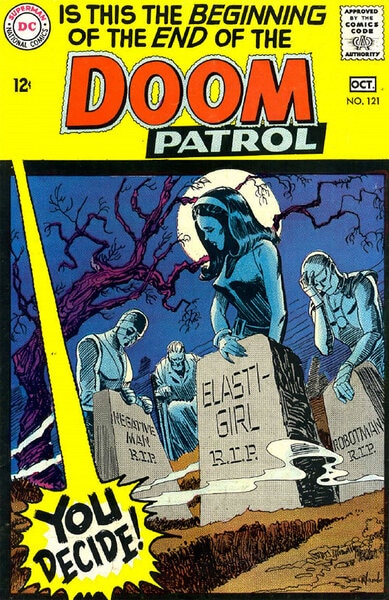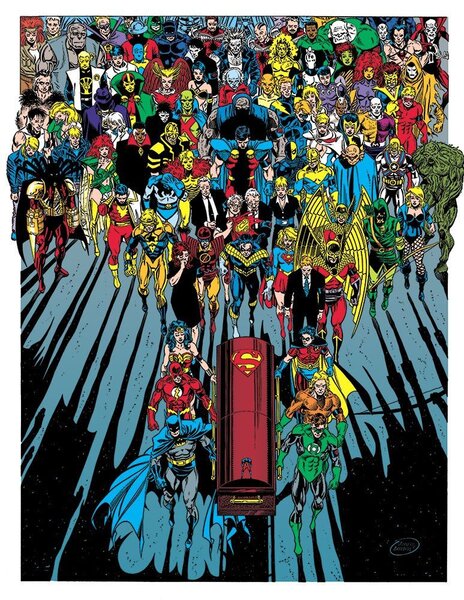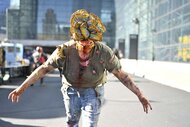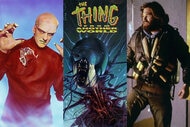Create a free profile to get unlimited access to exclusive videos, sweepstakes, and more!
Superheroes and the afterlife

“Nobody stays dead in superhero comics.” What was once a one-liner has transformed into one of the few consistent truisms that informs this entire subgenre of fiction. In the early days, some heroes did die with the intention of staying dead, but publisher mandates and fan outcry always led to an eventual return from the grave. Though some would say it cheapens the impact significantly, it means we get to keep reading Barry Allen comics.
As such, death for superheroes is definitely a very different matter than real death, which is irreversible. Yet most superheroes have been deceased at one point or another only to be returned to life right as rain and feeling better than ever a few months later. Is the superhero afterlife a writer’s retreat? Is it a spa?
It’s neither of those things, right? OK, we’d better take a closer look at this.
So, Why Don’t Superheroes Ever Really Die?
To put it simply, nobody dies in comics because comic characters aren’t just characters; they’re properties. They are action figures, TV shows, and T-shirts. The merchandising on a character like Batman draws in vast, almost unfathomable amounts of money year after year. To kill Batman would be to kill a seemingly unending moneymaker.
Not surprisingly, superhero comics usually avoid the physical reality professional athletes or even construction workers have to deal with on a regular basis, which is that putting your body on the line will always come at a price. In the comics, many superheroes have power sets that specifically prevent their bodies from harm, so we don’t have to read stories about the horrifying things that can happen to professional wrestlers or football players. Concussive head trauma, tearing of flesh and bone, and premature aging seldom occur in the world of mainstream comics.
Superheroes are essentially immortal. Villains come at Superman with everything they've got to destroy him, and he bats it away like it's nothing. For some, this invulnerability reads as exceptionally boring, and somehow the stakes must be raised in order to reignite interest in the series. In one instance, Wolverine was killed during Death of Wolverine, but he never really vanished from the timeline because clones and alternate reality versions of him were still around. When he returned, it also warranted another crossover, sprawling over many several issues. It may be cynical to say these choices are made for money, but it also happens to be true. That doesn’t disregard the creative element, but Logan is one character who had oversaturated the market for years by the time Death of Wolverine hit the stands. Giving him a short break drove sales up again, and that’s why it was done. This is simple, but it just isn’t how death works in most other mediums.
Early Comic DeathsThe Doom Patrol was the first comic series in which the team tragically died, never to return in the final issue in 1968. The extremely strange villains Madame Rouge and General Zahl nearly destroyed an entire town, but the Doom Patrol acted quickly and stopped her, sacrificing their own lives in the process. Naturally, a character like Robotman, who is the living brain of a man placed in a body of old metal parts, was quickly revealed to have survived the blast and began making appearances in comics again nearly a decade later. Meanwhile, Rita Farr remained deceased for decades, only returning in the early 2000s. Future writers seldom addressed what this meant for the characters or if they had ever experienced anything like the afterlife, but when she returned in 2006, Rita said, “I remember the explosion on the island. And then nothing but darkness. Am I supposed to be dead?”
Meanwhile, the character Boston Brand, aka Deadman, premiered in 1967. Brand was a daredevil acrobat who called himself Deadman and performed in stark white makeup, which became his regular appearance in death. He was murdered in the middle of his act one night, and Rama Kushna granted him the ability to temporarily possess living bodies in order to solve the mystery of who had killed him and to achieve justice.
Even after he discovered who had killed him, Deadman’s work was not done. He seemed to spend much of his time in the foggy, in-between realm of Limbo. He appeared in series other like Swamp Thing, gently coaxing people through the initial trauma of their deaths. While Brand is deceased, it is implied that there is a greater afterlife that he is prevented from joining.
The PhoenixObviously, the myth of the Phoenix, an unkillable bird of fire that perpetually crumples in ash only to rise again, is a fairly suitable comparison to make for Jean Grey. Though she had spent much of her teen years fighting mad scientists and mutant extremists, it was not until she merged with the cosmic entity Phoenix that Jean Grey was placed in the life-or-death scenario from which she could not escape. Having committed mass murder by feeding on the life force of an entire planet, Jean and the rest of the X-Men were forced to defend themselves from the Shi’ar, who gave Jean the death penalty and attempted to carry it out. Realizing what a hopeless fight it was and fearing what she might do if Phoenix took hold once more, Jean ended her own life.
Oh! It wasn’t Jean, though. Several years later, when editorial decided that they wanted to bring back the five original X-Men as a group for X-Factor, it was revealed that the entity that had died had merely been Phoenix impersonating Jean, and the real Jean was napping peacefully at the bottom of Jamaica Bay in a cocoon. Jean enjoyed many more years of life before dying again in New X-Men.
In the Jean Grey series, a younger Jean Grey is haunted by the ghost of an adult Jean, attempting to warn her and protect her from being possessed by the Phoenix Force. This fed into the series Phoenix: The Resurrection of Jean Grey, in which Jean was trapped in a Twilight Zone-style afterlife, repeating all the same mistakes and unable to break the cycle. She eventually fought through the illusions and returned to life, but, as usual, there is very little mention of what the afterlife is like. Far and away, Jean, like most other characters, just doesn’t remember it.
Death PartyIn Crisis on Infinite Earths, Supergirl and Barry Allen were killed. Both returned but not until several years later. With Barry, we discovered that he was merely trapped within the Speed Force, from which he eventually returned — while Supergirl, though she did indeed die in Crisis, was replaced by a clone, Matrix. Matrix bonded with an actual angel from Heaven, then likewise bonded with a troubled teen named Linda Danvers. Through this time period, there was quite a lot of references to the Christian ideals of Heaven and Hell, but all of that was more or less left in the dust when Kara Zor-El was finally reintroduced to the DC Universe.
Meanwhile, Superman was killed during a fight with Doomsday during the famous Death Of Superman storyline. The follow-up, Funeral For A Friend, showed a world reeling from the loss, while World Without Superman saw other heroes stepping up to attempt to fill the void he left behind. Again, we don’t hear much about what it’s like to be dead when Superman returns. Everyone is glad he’s back, but there’s very little in the way of spiritual commentary.
Of course, for Superman’s best friend, Batman, there is the constant threat of the Lazarus Pit. Utilized by Ra’s Al Ghul to stay alive for decades or even centuries beyond his intended lifespan, it is a supernatural rejuvenator that eventually saw the former Robin Jason Todd returned to life after spending years in the land of the dead. Todd was killed by the Joker after a bizarre marketing ploy in which DC fans were encouraged to call and vote whether he should live or die. Perhaps convinced that DC would never fulfill the threat, fans voted that Todd should be killed, and that’s exactly what happened. Years later, he returned, but it is implied that abuse of the Lazarus Pit caused him deep psychological problems that took some time to even begin to work out.
Finally, the Green Lantern Hal Jordan was possessed by Parallax after his hometown was destroyed. Pushed beyond his breaking point, Jordan attempted to resurrect Coast City simply by willing them back into existence with his ring. These attempts escalated until he eventually attempted to rewrite reality entirely, which led to the difficult-to-follow Zero Hour crossover. By the end, Hal Jordan was dead, but he returned not long after in the form of the spirit of vengeance, Spectre. This likewise did not last long, and now Hal Jordan is back to normal and the same as he ever was, even after all that.
Undead Superheroes
Finally, we have zombies. Marvel Zombies takes place in an alternate reality which has been overrun by undead superheroes, and that is exactly the gore-filled nightmare that it sounds like. There isn’t much else to say about it past the title, but rest assured that if you ever wanted to read a version of Marvel, but with everyone as zombies? Marvel Zombies is here for you.
DC’s crossover event Blackest Night offered a similarly new version of the Green Lantern referred to as the Black Lantern, their ring only to be worn by the deceased. Evil, rotted-out caricatures of heroes who were supposedly dead at the time returned from their graves to haunt their former friends and lovers, feeding off of the emotional reactions of the living as they taunted them about their past failures.
Truly, there is no end to bizarre takes on the afterlife in comics, and we’ve really only touched the tip of the iceberg here. As for what the afterlife is really like, maybe we don’t know, but if reading comics has taught us anything, it’s pretty much just like hanging out in an isolation tank for a couple hours. That sounds less scary than most of our other ideas, but still pretty intimidating.

















